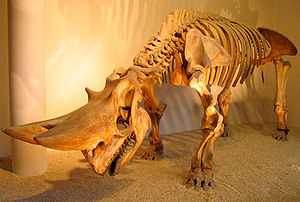Embrithopoda
| Embrithopoda Temporal range: Eocene - Oligocene, 35–28Ma | |
|---|---|
 | |
| Arsinoitherium zitteli | |
| Scientific classification | |
| Kingdom: | Animalia |
| Phylum: | Chordata |
| Class: | Mammalia |
| (unranked): | Afrotheria |
| (unranked): | Paenungulata |
| (unranked): | Tethytheria Court 1990[1] |
| Infraorder: | †Embrithopoda[2] Andrews 1906 |
| Families | |
Embrithopoda ("heavy-footed") is an order of extinct mammals known from Asia, eastern Europe, and northern Africa. Most of the embrithopod genera are known exclusively from jaws and teeth dated from the late Paleocene to the late Eocene, but the order is best known from its terminal member, the elephantine Arsinoitherium.[3]
Description
While embrithopods bore a superficial resemblance to rhinoceroses, their horns had bony cores covered in keratinized skin and were not made of hair. Not all embrithopods possessed horns, either. Despite their appearance, they were related to elephants, not perissodactyls.[4]
The Embrithopoda are tethytheres[5] and are also believed to be part of the clade Afrotheria.
Fossils of embrithopods, such as Arsinoitherium, have been found in Egypt, Mongolia, Turkey and Romania. Until the 1970s, only Arsinoitherium itself was known, appearing isolated in the fossil record.[4]
Classification
McKenna & Manning 1977 and McKenna & Bell 1997 considered Phenacolophus from Mongolia a primitive embrithopod, but, though similarities certainly exist, this attribution has been challenged by several other authors.[6]
Order Embrithopoda Andrews 1906
- Family Arsinoitheriidae Andrews 1904
- Genus Arsinoitherium Beadnell 1902
- Family Palaeoamasiidae Şen & Heintz 1979
Notes
| Wikimedia Commons has media related to Embrithopoda. |
| Wikispecies has information related to: Embrithopoda |
- ↑ N. Court 1990 in the Paleobiology Database. Retrieved April 2013.
- ↑ Rose 2006, pp. 242–3
- ↑ Rose 2006, p. 265
- ↑ 4.0 4.1 "Introduction to the Embrithopoda". University of California Museum of Paleontology. Retrieved March 2013.
- ↑ Embrithopoda in the Paleobiology Database. Retrieved March 2013.
- ↑ Radulesco & Sudre 1985; Maas, Thewissen & Kappelman 1998, p. 291; Rose & Archibald 2005, pp. 97–98
References
- Andrews, C.W. (1904). "Further notes on the mammals of the Eocene of Egypt". Geological Magazine 1 (4). doi:10.1017/S0016756800119491. OCLC 4668923377.
- Andrews, C.W. (1906). A descriptive catalogue of the Tertiary Vertebrata of the Fayûm, Egypt. London: British Museum. OCLC 3675777.
- Beadnell, H.J.C. (1902). A preliminary note on Arsinoitherium zitteli Beadnell, from the Upper Eocene strata of Egypt. Cairo: Egyptian Survey Department, Public Works Ministry. OCLC 20609512.
- Court, N. (1990). "Periotic anatomy of Arsinoitherium (Mammalia, Embrithopoda) and its phylogenetic implications". Journal of Vertebrate Paleontology 10 (2): 170–82. doi:10.1080/02724634.1990.10011806. OCLC 4899524631.
- Maas, M.C.; Thewissen, J.G.M.; Kappelman, J. (1998). "Hypsamasia seni (Mammalia: Embrithopoda) and other mammals from the Eocene Kartal Formation of Turkey". In Beard, K.C.; Dawson, M.R. Dawn of the Age of Mammals in Asia (PDF). Bulletin of Carnegie Museum of Natural History 34. pp. 286–297. OCLC 493312921. Retrieved May 2013.
- McKenna, Malcolm C.; Bell, Susan K. (1997). Classification of Mammals Above the Species Level. New York: Columbia University Press. ISBN 0231110138. OCLC 37345734.
- McKenna, M.C.; Manning, E. (1977). "Affinities and palaeobiogeographic significance of the Mongolian Paleogene genus Phenacolophus". Geobios, Memoire special 1: 61–85. doi:10.1016/S0016-6995(77)80008-9. OCLC 4656767437.
- Ozansoy, Fikret (1966). Türkiye Senozoik çağlarında fosil insan formu problemi ve biostratigrafik dayanakları. A.Ü. D.T.C.F. (University of Ankara, Faculty of Languages, History and Geography Publications) 172. Ankara University Press. pp. 1–104. OCLC 16763756.
- Radulesco, C.; Iliesco, G.; Iliesco, M. (1976). "Decouverte d'un Embrithopode nouveau (Mammalia) dans la Paléogène de la dépression de Hateg (Roumanie) et considération générales sur la géologie de la région". Neues Jahrbuch für Geologie und Paläontologie Monatshefte 1 (11): 690–698.
- Radulesco, C.; Sudre, J. (1985). "Crivadiatherium iliescui n. sp., nouvel Embrithopode (Mammalia) dans le Paléogène ancien de la depression de Hateg (Roumanie)". Palaeovertebrata 15 (3): 139–57.
- Rose, Kenneth David (2006). The beginning of the age of mammals. Baltimore: JHU Press. ISBN 0801884721.
- Rose, Kenneth D.; Archibald, J. David (2005). The Rise of Placental Mammals: Origins and Relationships of the Major Extant Clades. JHU Press. ISBN 9780801880223. OCLC 55801049. Retrieved March 2013.
- Sanders, William J; Kappelman, John; Rasmussen, D Tab (2004). "New large-bodied mammals from the Late Oligocene site of Chilga, Ethiopia" (PDF). Acta palaeontologica polonica 49 (3). OCLC 716778291.
- Şen, Ş.; Heintz, E. (1979). "Palaeoamasia kansui Ozansoy 1966, embrithopode (Mammalia) de l'Eocene de Anatolie". Annales de paléontologie (Vértébres) 65 (1): 73–91.